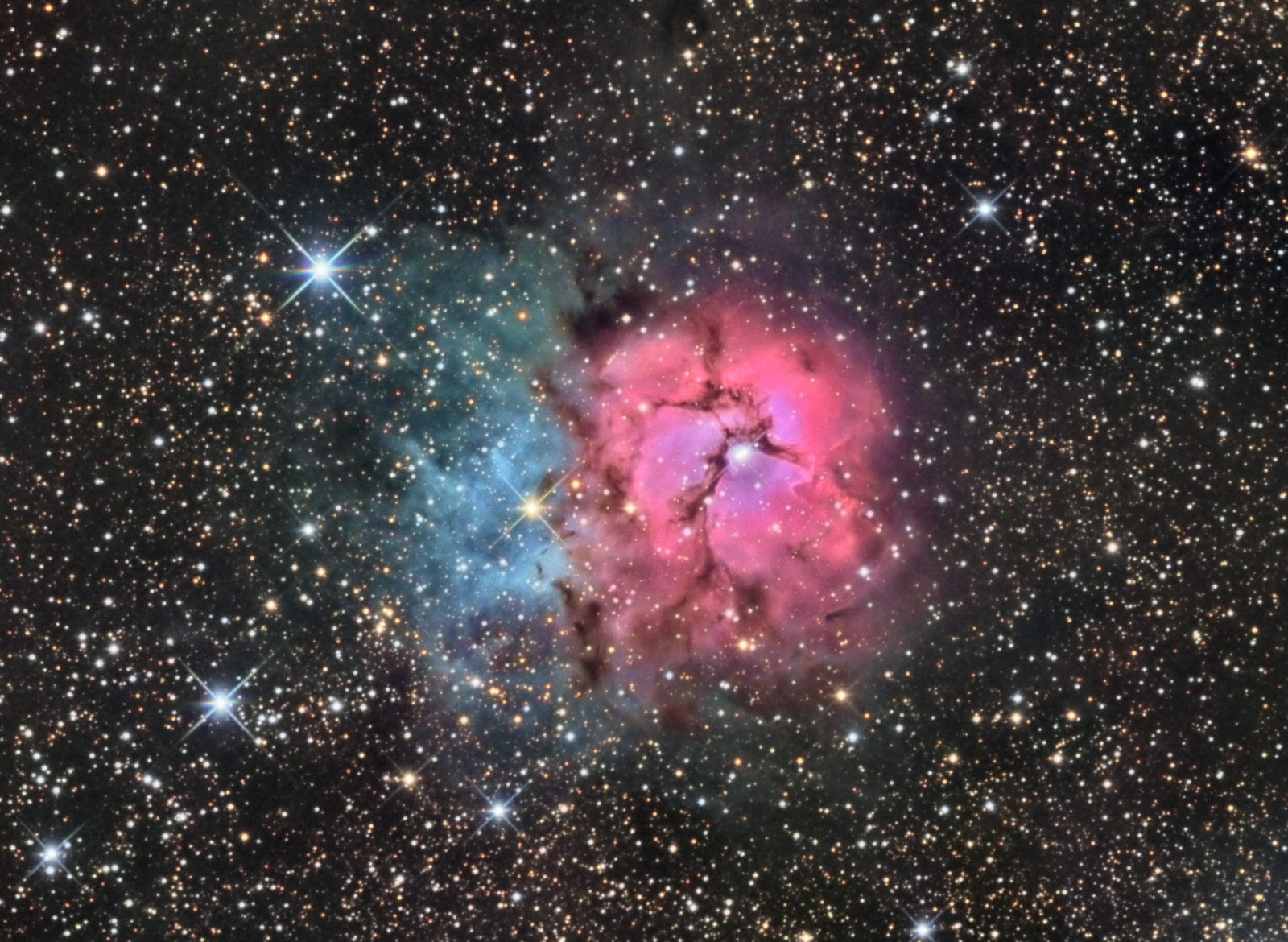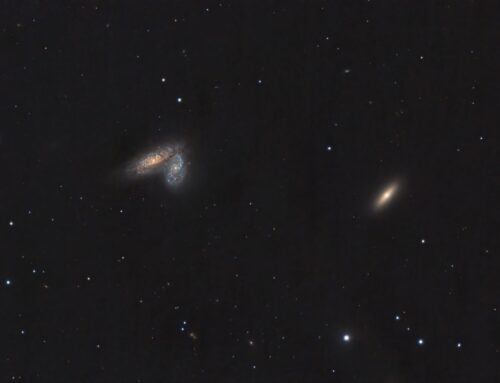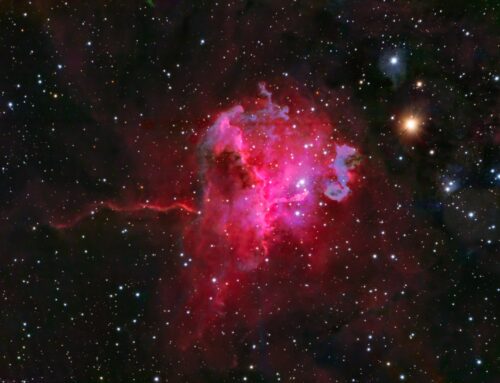M20, The Trifid Nebula
 Click image for full size version
Click image for full size version
August 17, 2016
The famous Trifid Nebula is catalogued as Messier 20. Its name means “divided into three lobes” although today’s equipment shows more than three main “clumps” in the nebula. This target shows four different classes of deep-sky object in one: star cluster, emission nebula (red hues), reflection nebula (blue hues), and dark nebula (brown features; also designated Barnard 85). It lies 5,200 light years away in Sagittarius and its width is similar to the Moon’s.
This image of M20 was taken during the week of the Starfest star party in 2016, and the two weeks afterwards. I faced three major challenges in acquiring this shot: 1) This object is so low in the sky for me that I could only access it for about an hour each night, so it took 5 or 6 nights to get the image. 2) The Guelph auto mall’s light pollution ruins this part of my sky. 3) The object was so low that my observatory walls partly obstructed the view — the the “extra” horizontal spikes on the bright stars are caused by the walls of my observatory (red, green and blue spikes don’t quite line up because different filters were used at different times of each night).
Tekkies:
SBIG STL-11000M camera, Baader R, G and B filters, 10″ f/6.8 ASA astrograph, Paramount MX. Guided with QHY5 guide camera and 80 mm f/6 Stellar-Vue refractor. Acquisition, guiding and mount control with TheSkyX. Focusing with FocusMax. Automation with CCDCommander. All preprocessing and post-processing in PixInsight. Shot from my SkyShed in Guelph, Ontario. No moonlight, good to excellent transparency, and good to very good seeing throughout acquisition.
19x5m R, 15x5mG, 18x5mB unbinned frames (total=4hr20m).
RGB
Creation and cleanup: R, G and B masters were cropped and processed separately with DBE. R, G and B were combined to make an RGB image which was processed with ColourCalibration.
Linear Noise Reduction: MultiscaleLinearTransform was used to reduce noise in the background areas. Layer settings for threshold and strength: Layer 1: 3.0, 0.5 Layer 2: 2.0, 0.35 Layer 3: 1.0, 0.2 Layer 4: 0.5, 0.1
Stretching: HistogramTransformation was applied to make a pleasing yet bright image.
Synthetic Luminance:
Creation and cleanup of SynthL: The cleaned up R,G and B masters were combined using the ImageIntegration tool (average, additive with scaling, noise evaluation, iterative K-sigma / biweight midvariance, no pixel rejection).
Deconvolution: A copy of the image was stretched to use as a deconvolution mask. A star mask was made from unstretched SynthL to use as a local deringing support. Deconvolution was applied (80 iterations, regularized Richardson-Lucy, external PSF made using DynamicPSF tool with about 20 stars; local deringing at 70% and global dark deringing at 0.03).
Linear Noise Reduction: MultiscaleLinearTransform was applied to reduce the noise. Layer settings for threshold and strength: Layer 1: 3.0, 0.5 Layer 2: 2.0, 0.35 Layer 3: 1.0, 0.2 Layer 4: 0.5, 0.1
Stretching: HistogramTransformation was applied to make a pleasing yet bright image. TGVDenoise was applied and the image was re-stretched to reset the black point.
Dynamic Range Adjustment: HDRMultiscaleTransform was applied at 6 and 4 pixel scales, using a mask to protect background, faint nebula and stars. LocalHistogramEqualization was run at scales of 50 and 150 pixels to restore contrast, again using a mask.
Combining SynthL with RGB:
The luminance channel of the RGB image was extracted, processed and then added back into the RGB image as follows:
1. Extract luminance from the RGB image.
2. Apply LinearFit using SynthL as the reference.
3. Use ChannelCombination in Lab mode to replace the RGB’s luminance with the fitted luminance from step 2.
4. LRGBCombine was then used to make a SynthLRGB image.
Final Processing of SynthLRGB:
MultiscaleLinearTransform was applied to sharpen the brightest parts of the nebula (bias +0.06 for layers 2 and 3), protecting other areas with a mask.
The DarkStructureEnhance script was applied with a strength of 0.07 to slightly darken dark nebulae. Background, stars and nebula brightness, contrast and saturation were adjusted in several iterations using Curves with masks as required.
Image scale is about 1.1 arcsec per pixel for this camera / telescope combination.






Fantastic and thanks for sharing your workflow, it is very helpful to me as a beginner!